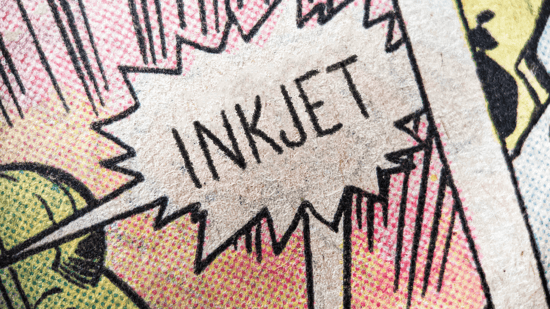Dots vs. Drops: A Glossary of Common Ink Terminology

Ink is often one of the more mysterious parts of designing projects for digital inkjet, in large because the world of ink can be complex and highly nuanced. A basic understanding of common ink terminology and concepts can go a long way toward helping designers produce higher quality inkjet pieces, as how inks are formulated and transferred to a given sheet can impact things like image and color quality.
“The ways that inkjet presses achieve image quality go well beyond the number of dots,” write Elizbeth Gooding and Mary Schilling, authors of The Designer’s Guide to Inkjet, 3rd Edition. “It is based on the ink volume of drops jetted, the size of the dots that can be created, the number of distinct sizes, the shape of the drops, and uniformity of the resulting dots on the page.”
Here, we’ll define some of the more common ink terms and concepts to help designers streamline the design and production process, and maximize their use of digital inkjet technology.
What is DPI?
DPI (dots per inch) is a measurement of the number of ink droplets a print device produces while printing an image. The more dots of ink per inch an image has, the more detail you can expect when the image is printed. DPI is used in part to help determine the overall quality of a print asset, and 300 DPI is typically the benchmark designers look for in printing high-quality images for inkjet, though it’s important to note that larger images may require a higher DPI for the same quality.
What is an ink drop vs. an ink dot?
Though often confused with an ink dot, an ink drop is what comes out of the printhead of the print device. Ink drops are measured by volume in picoliters, and different types of printheads produce different ink drop volumes.
For example, binary printheads generate drops in just one size — though they can transfer as many as three drops on the same spot on the sheet — and multi-drop printheads automatically generate drops of varying volumes. Understanding ink drop is key to predicting how the ink will respond once it is transferred to the substrate.
An ink dot is what an ink drop becomes once it hits a substrate. Ink dots are measured by diameter in millimeters, and how an ink dot interacts with the paper helps determine the amount of dot gain.
What is dot gain?
Dot gain is the difference between the size of the dot when it hits the paper vs. when it is absorbed into the sheet. The greater the amount of dot gain, the darker and less crips an image will appear on a printed sheet.
“If dots spread unevenly as they absorb into the paper, the image clarity and text legibility may be diminished,” write Gooding and Schilling. “Every combination of paper and ink produces a different amount of dot gain based on the paper surface and ink viscosity.”
Read more about the relationship between ink and paper in digital inkjet production.
What is ink density?
A measurement of how much light is reflected from a printed surface, ink density is a numeric value that is calculated using a densitometer. The density of a particular ink printed on a particular paper can change based on the thickness or total area coverage (TAC) of ink.
What is total area coverage?
TAC refers to the amount of ink that can be on any one area of a sheet. TAC also describes the highest total thickness of the combined ink for a specific print job. TAC is an incredibly important concept when printing on a digital inkjet device because each kind of paper can only support a certain amount of ink before the ink will fail to dry properly.
“High TAC with insufficient drying can cause problems like coalescence, mottling, show-through, and curl,” write Gooding and Schilling.
What is ink wicking?
Also referred to as bleed, ink wicking refers to the actual movement of ink when it comes in contact with paper. When ink wicks, it follows the surface of the paper fiber, creating something of a fuzzy appearance called feathering. Ink wicking happens vertically and horizontally on the paper surface and will cause printed text, lines, and images to lose their sharpness or clarity.
What is ink dive?
Whereas ink wicking involves the spread of ink both vertically and horizontally on the page, ink dive occurs when ink dives into the actual fibers of the sheet. Caused by rapid absorption into the sheet’s fibers, ink dive produces a number of print defects, including paper cockle, show-through, and mottling.
What is mottle?
Mottling occurs when ink wicking and ink dive combine, causing irregular absorption that can be seen on the surface of the paper. When ink colorant is absorbed at different rates, it can create a blotchy or streaky look, and it is commonly most apparent in solids and image midtones. It’s important to note that some uncoated papers are predisposed to mottle because the structure of the paper lacks a solid foundation for aqueous inks.
While this glossary will give you a solid foundation on common ink terms and concepts, there’s still much to know about the different types of ink formulations, and what makes these types of ink more or less compatible with specific kinds of paper. The Designer’s Guide to Inkjet, 3rd Edition is the resource designers need for all things ink and more.
Download the guide to learn more.
See More Like This
See MoreMarketing Collateral
Project Spotlight: A Stunning Course Catalog for An Interactive Online Academy
Marketing Collateral
Project Spotlight: The Age of iQuarius Tour Hits the Road
Marketing Collateral
Project Spotlight: A Bold Postcard to Announce the New Canon ProStream 3000 Series
Marketing Collateral
Project Spotlight: A Journal Designed to Help Users Explore and Discover